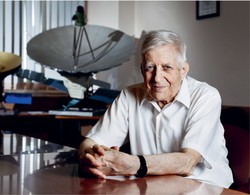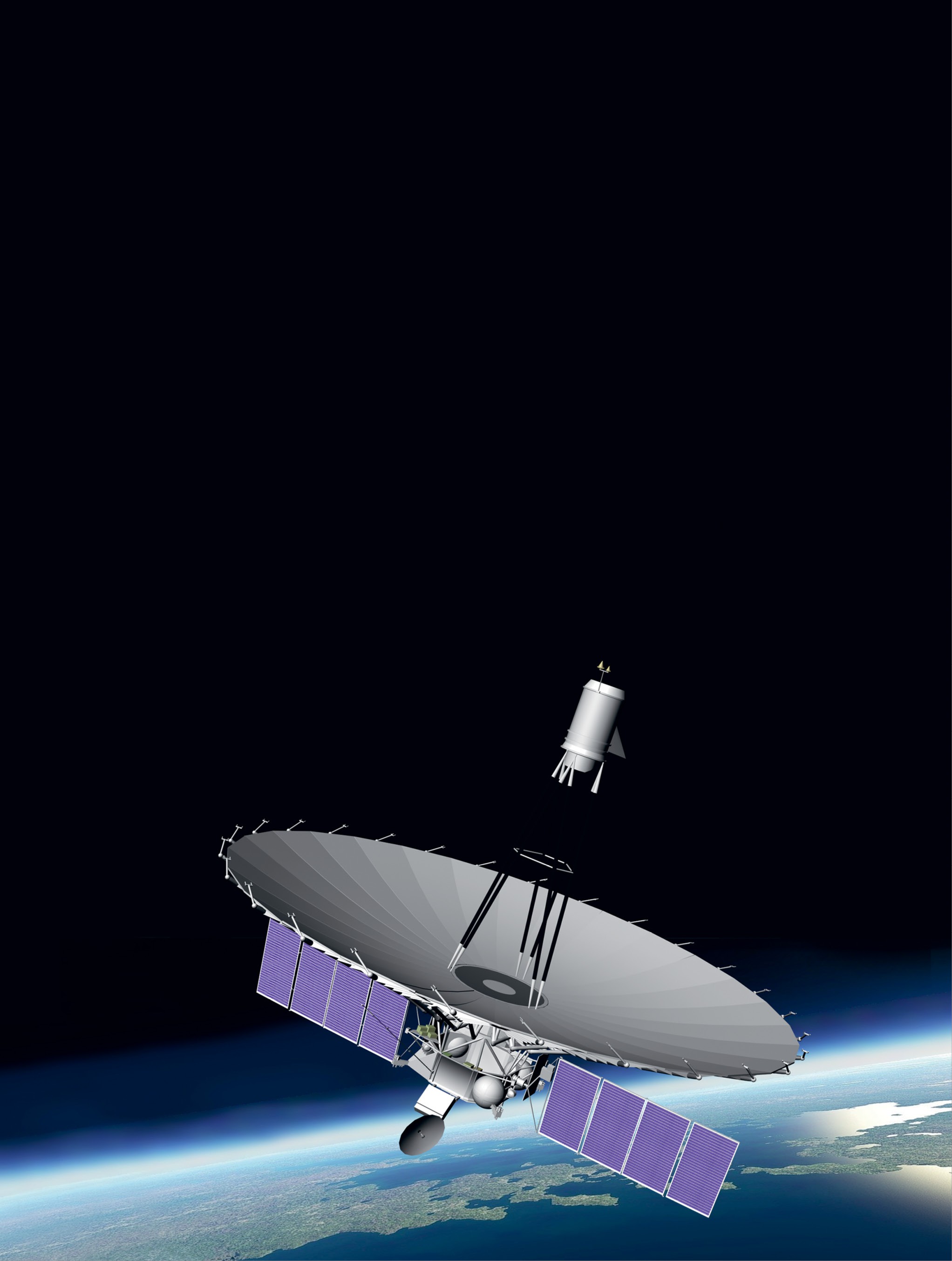With an Aided Eye
A radio telescope as big as the distance between the Earth and the Moon is helping to unlock the mysteries of the nucleus of our galaxy
Nikolai Kardashev – one of Russia’s best known international astrophysicists – initiated a mega-ambitious project to deploy interferometers both on Earth and in space with the super long Radioastron and Millimetron bases. Radioastron, also known as Spektr-R, has already been in orbit for four years. But Kardashev, a member of the Russian Academy of Science and Director of the Russian Academy of Science Institute of Physics, has earned even greater fame for his efforts to find traces of extra-terrestrial life forms, black holes, and wormholes.
What is Radioastron? When did the need for something like this arise and why?
It all started nearly 50 years ago. Soon after radio astronomy was invented, people wanted to observe radio sources discovered in the sky in images with similar levels of granularity to those provided by optical telescopes. Radio telescopes, much like optical telescopes, have two main parameters: image sensitivity and granularity (angular resolution). The former is determined when registering the radiation emitted by the subject of your studies. The latter parameter depends on the ratio between the wavelength (spectrum) and the size of the telescope. In optical telescopes, the spectrum would range from red to blue, and in radio telescopes, it ranges from kilometer- to millimeter-long waves. In the early 20th century, astronomers could only use optical images, but later we learned to build radio telescopes. In optical light, the wavelength amounts to one millionth of a micron. That is why our objective was to make a radio telescope that would be a thousand or even a million times larger than its optical counterpart.
The key outcome is that we have been able to determine the size (or at least the upper limits) of many astronomical objects, as well as other parameters, thanks to the exceptionally high angular resolution of the earth-space interferometer. We are currently studying three types of sources. Most of our time is spent looking at the nuclei of other galaxies with black holes at their heart, the mass of which is millions and billions of times greater than our Sun. We have studied 136 objects of this kind
Initially, radio astronomers had to cope with images that offered a much lower level of granularity and were obtained with the help of parabolic antennas, similar to the satellite TV antennas that have become ubiquitous now. These ‘dishes’ can now be several hundred meters across, but this is nowhere near enough. So scientists started pondering how to get the same image quality as optical telescopes. The main idea behind the interferometer is not necessarily to come up with an integral telescope lens – images can be built using a large number of smaller separate lenses as long as there is a way to link them. Initially, the antennas in radio interferometers were connected by cables. To extend the size of the base further meant extending the length of the cable – a difficult and expensive proposition. In the 1960s, my colleagues L. I. Matveenko, G. B. Sholomitskiy, and I came up with a new interferometer design: we could use a simple tape recording of signals from each separate interferometer element, and then bring all of these recordings together in one place and process them. This is how interferometers with independent registration came about. Radio astronomers from other countries immediately showed an interest in implementing this project with us – after all, this raised the prospect of coming up with any base and achieving a very high resolution that would approximate that of an optical telescope and might even surpass it. Before long, this method was extended to an intercontinental scale to launch research into astronomical objects. These projects managed to obtain an angular resolution that was many times higher than that offered by the largest optical telescopes.
When the idea of creating an interferometer with independent registration was first formulated, we already began to talk about sending a radio telescope into space in the future and creating an earth-space interferometer with even greater resolution. With this in mind, an automatic parabolic antenna was built with a meshed reflective surface and a diameter of 10 meters. The configuration also included 12 cm and 72 cm wave receivers, and the radio telescope was delivered to the Salut-6 space station on 30 June 1979 by a Progress cargo spaceship. Two cosmonauts, Vladimir Lyakhov and Valeriy Riumin, installed and opened the antenna on one side of the station and used astronomical sources to study the telescope’s parameters until 9 August 1979.
Creating a space radio telescope became an international effort. But, with the significant changes that affected our country, Russian scientists were beaten to the punch in 1997 when the Japanese launched VSOP, a satellite that sounds more like a cognac. Their parabolic antenna also had a meshed reflective surface, but its diameter was 8 meters. It covered waves of 6 cm and 18 cm, while its maximum distance from Earth (interferometer base) was 21,400 kilometers. For us, it was a bit of a disappointment to see someone else complete a project that we had started long before.
Our Radioastron has a 10-meter antenna whose surface is covered with panels made of aluminum-coated carbon fiber. It covers the spectrum of 1.35 cm, 6.2 cm, 12 cm, and 92 cm. It was built by a team that included various international stakeholders. The satellite was launched into orbit on 18 July 2011 from the Baikonur space center using a Ukrainian-made Zenith-3M rocket. Its maximum distance from Earth is 350,000 kilometers – nearly the distance between the Earth and the Moon. Our next telescope – Millimetron – is already in the making; its mirror diameter will be 10 meters it will cover the spectrum from 0.3 to 16 millimeters, and its maximum distance from Earth will be 1.5 million kilometers.
Radioastron has been in orbit for four years. What are the results?
There are already more than 40 articles about this launch. The next step is a thorough study of each source to create a summary of the results. The key outcome is that we have been able to determine the size (or at least the upper limits) of many astronomical objects, as well as other parameters, thanks to the exceptionally high angular resolution of the earth-space interferometer.
We are currently studying three types of sources. Most of our time is spent looking at the nuclei of other galaxies with black holes at their heart, the mass of which is millions and billions of times greater than our Sun. We have studied 136 objects of this kind.
Our second priority area is to study the regions where stars and planetary systems are born. We have observed a dozen of these objects. We are carrying out detailed studies of areas that have very dense hot gas where a new star has already been born and where planets are probably taking shape too. Radioastron gave us high-resolution images of these regions, which we are planning to study further. There are many regions of this kind in our galaxy, about a hundred, so slowly but surely we will study them all. This year, we managed to observe a starburst region in another galaxy. It turns out that in a region dominated by a central super-massive black hole, new stars can also be born in the surrounding gas. This region is very similar in structure to what we have in our vicinity. Of course, it would be good if we could confirm once and for all that what we are observing is not only stars but also the birth of new planets.
Our third objective is to study the most compact radio sources. These are pulsars or neutron stars. The radius of such a star is approximately 10 km and conditions there are absolutely unimaginable: huge density, insanely powerful magnetic and electric fields. When the dipolar magnetic field axis is directed at the observer, revolving neutron pellets emit monstrously powerful impulses in all spectra, from radio and optical to X-ray and even Gamma ray. We have observed 24 pulsars and discovered totally new regularities when radio waves from these sources reach us through the interstellar matter.
On top of all of this work, we have another objective initiated by the P. K. Sternberg State Astronomical Institute (SSAI, Moscow State University). This could potentially affect the fundamentals of physics. We are talking about measuring the gravitational red shift in the gravitational field of the Earth. Radioastron has the world’s first atomic frequency standard. It was developed in Nizhny Novgorod by a company called Vremya-CH. It is a super stable electronic generator based on hydrogen atom radiation. By comparing signals received from the space generator with a frequency standard installed in a lab on Earth, we see a small difference in their frequencies depending on Radioastron’s movement along the orbit. This difference is predicated not only on the satellite’s speed (the Doppler effect), but also on the gravitational field of the Earth. I hope that we will receive more accurate data than we had before. Ultimately, when we discover the magnitude of the frequency shift, we will be able to compare it with the values derived from formulae in the general theory of relativity.
Are you happy with the results of the last four years and what do you expect to achieve from processing the data you accumulated?
I am happy and expect very interesting results in the future. We have yet to finish our observations and processing even with respect to those sources that are located closer to us. I would like to see everything in greater detail. In the fall, we will study the nucleus of our galaxy. We have yet to complete the images we received from observing some of the closer galaxies. Our processing work has been completed for only a few objects, and those articles have been submitted for publication, while the vast majority of them are still waiting their turn. Naturally, we would like to obtain data on both the closest and the farthest sources and different types of objects with the greatest possible number of bases. For instance bases located more than 300,000 kilometers away yielded results about 10 sources. We need to observe more sources to get a statistically reliable classification and see how they are different from one another and what specific attributes they have.
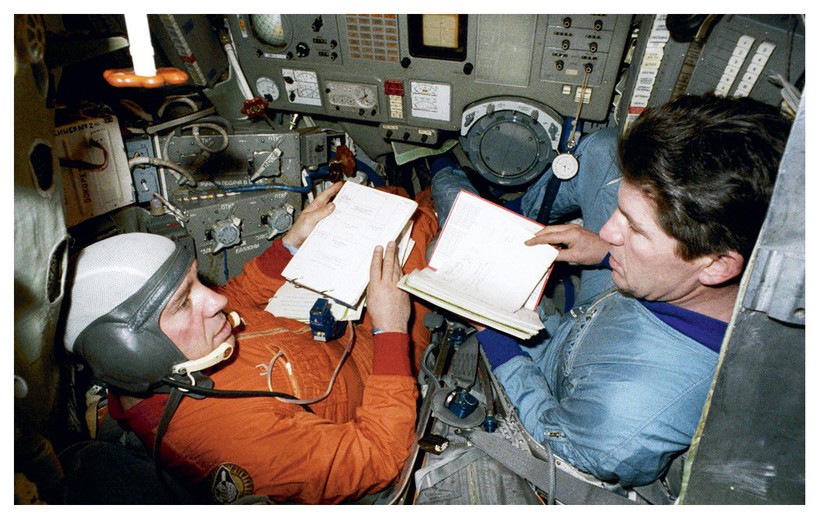
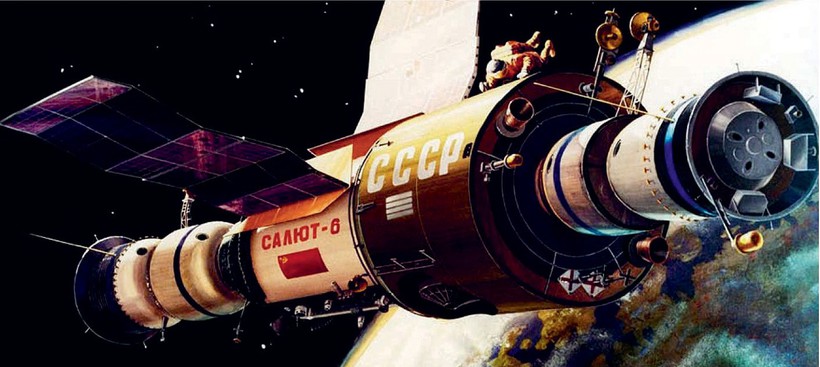
The radio telescope was delivered to the Salut-6 space station on 30 June 1979 by a Progress cargo spaceship. Two cosmonauts, Vladimir Lyakhov and Valeriy Riumin, installed and opened the antenna on one side of the station and used astronomical sources to study the telescope’s parameters until 9 August 1979
Will Radioastron be capable of penetrating clouds of dust and gas and getting through to the center of our galaxy?
Dust does not absorb radio waves but plasma may significantly disperse them and even absorb them. There are many assumptions about what surrounds the center of our galaxy, and all of those will have to be refuted or confirmed through experiments. Today Radioastron helped us to discover that the images we receive contain some very compact details. But it is still hard to pinpoint what they are. Maybe some new information will come from our observations in the future. Speaking of the center of our galaxy, there is no data that has not been processed. We have left no stone unturned. Our hopes now are hanging on a new series of observations.
Is it possible that a super massive black hole determines the structure of the galaxy to a certain extent or at least its ‘effects’ determine much of what surrounds it?
To an extent, yes. In certain parts of the Universe, there can be explosions near super massive black holes, but it seems that they only happen when two galaxies collide. An explosion happens when a large object falls into a black hole, such as another black hole or a compact constellation. Galaxies have very different sizes and some are very small. There are also globular star clusters. I think that if something of this kind falls into a black hole in the center of our galaxy, it may cause a huge explosion that could even affect life on Earth. But so far we do not expect anything of this sort to happen.
It appears that Radioastron represents Russia’s only practical scientific breakthrough for many years. Is that really the case?
Yes, and it reflects the difficulties that scientific development faces in our country. Our new large-scale space research program was adopted in June 1990 and a decision was taken in the Kremlin to create four astronomical observatories in outer space. In fact, we are still working on a program that was approved back in the Soviet Union.
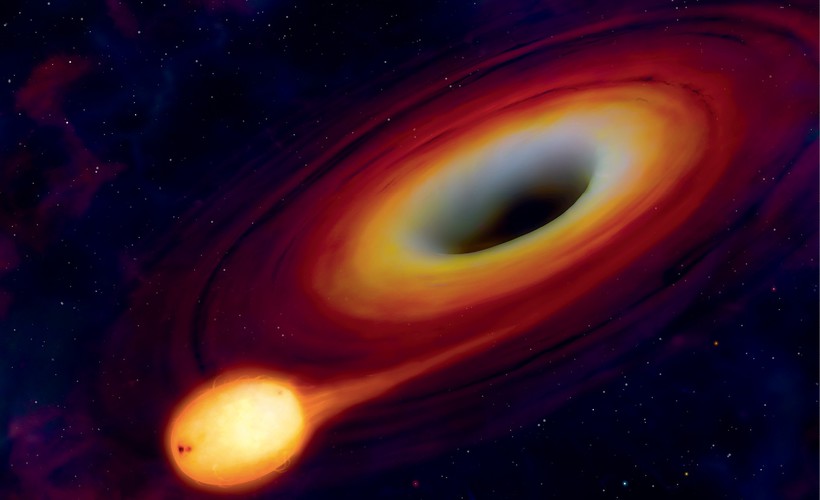
All black holes, no matter how far or how near, small or large, will become ‘visible’ to us, as the resolution will be high enough. So far nobody has actually discovered an actual black hole. We need a picture, a dark place surrounded by fluorescent objects and gas. Artists are already drawing this picture, but what is going on in reality is hard to reproduce because there is too much uncertaintyNow we are preparing to launch an X-ray telescope (Spektr-RG), an optical telescope (Spektr-UF), and the Millimetron observatory. We expect it to happen around 2020.
Do you believe it is a matter of management and not just shortage of funds?
We are often short of funds because money is spent in other areas that are not really necessary. Many important facets of our country’s economy are short of funds, including that aviation and automotive industries.
Despite these problems, Radioastron has attracted interest far beyond Russia, the United States, and Europe. China wants to replicate your project, while South Africa is looking to join it in a certain capacity.
We have an agreement in place with South Africa. Unfortunately, the overall situation in that country is quite complex and they cannot fulfil their obligations. We were supposed to have another station to receive information from the Radioastron satellite – the only one in the Southern Hemisphere. We planned to make it using the antennas that South Africa has in abundance. However, what they are clearly lacking is technical staff. Although an agreement has been signed, nothing good will come out of it, in my opinion.
The Chinese also want to cooperate with us, and we hope that we will be able to use the Radioastron program to conduct joint interferometer-based observations using their terrestrial telescopes. But at this stage, their own space project remains vague. They were planning to launch two satellites at the same time. This would expedite the process of obtaining images significantly. We will be very happy if their project works out. At this stage, our key partners, whose radio telescopes form the backbone of our space interferometer on Earth, are Australia, England, Germany, Holland, India, Spain, Italy, Poland, the United States, France, and Japan. But China and South Africa are our partners as well.
We have another project that is part of an intergovernmental agreement; it is slated to be implemented before we launch Millimetron. The observatory building has already been built in the mountains of Uzbekistan, and we have started assembling the world’s largest radio telescope operating in the millimeter spectrum to serve as the backbone of our space interferometer on Earth. The diameter of its mirror is 70 meters. Our Uzbek partners have already fulfilled all of their obligations. They have built reliable communications and roads, and provided security personnel.
How many years will Radioastron remain in operation and what does that depend on?
Nobody knows for certain. We are still receiving funding. All the systems are constantly checked for performance, and we are discussing whether there are any significant failures or deterioration in service. So far nothing serious has happened and our observation plan is extended every year. Of course, the equipment is exposed to intensive space radiation – micro meteors fly by close to it as well as parts of other satellites, which may cause a collision at any moment. But we hope that it will remain in operation until 2021.
When are you planning to launch Millimetron?
To a large extent, this depends on how we and our partners are able to fulfil our obligations. The launch is long overdue. I hope we are going to do it in 2020–2021. We’ll do our best to make it happen. Under the old plan, the launch was supposed to take place in 2018, but we are clearly behind schedule. International cooperation is really vital for us and it is important that we avoid sanctions. We are negotiating with many countries, but decisions are often delayed.
What kind of a breakthrough do you expect from Millimetron? What will it deliver that Radioastron is not capable of?
All black holes, no matter how far or how near, small or large will become ‘visible’ to us, as the resolution will be high enough. So far nobody has actually discovered an actual black hole. We need a picture, a dark place surrounded by fluorescent objects and gas. Artists are already drawing this picture, but what is going on in reality is hard to reproduce because there is too much uncertainty: stellar matter is falling, gas is falling, as are magnetic fields and dark matter (which we know very little about), but what does dark energy give us?
Do you also expect to find wormholes, to see them and study them?
Everything is connected. If we look at the center of a galaxy, we will see whether its center is dark or light. If it is light, we have a wormhole. There is no question about how to tell a wormhole from a black hole. All we need to do is to make our way through the gas and plasma around it. Only very short waves can penetrate them – millimeter-long waves penetrate plasma better than ordinary radio waves, which is why we need to launch Millimetron as soon as we can. There are scientists who treat the very idea of wormholes as a certain mathematical abstraction. But, even if it is an abstraction, it has every right to exist. It was Einstein who first came up with the idea. There are no mistakes in the theory, for sure. A wormhole might develop in a variety of different ways, but there is no doubt that it could really exist. On the other hand, nature offers much more than we are capable of comprehending. However, there are no laws that would rule out such a phenomenon.
Does this mean the Multiverse is not impossible either?
On the contrary, entire books are written on the subject. Here, of course, it is easier to imagine certain scenarios rather than to observe real evidence. Only wormholes would enable us to actually see something, but it is not hard to come up with an abstract metaphor: imagine there is a room and another one adjacent to it. If you have never been in this other room, you have no way of knowing what is going on there. Obviously, there are windows and walls and there are people who live there. The simplest assumption is that everything is the same there. If there were a peephole in the wall, we could peek through it. But there are far more complex models that presuppose different space dimensions in a different universe, a different kind of physics. But this is a purely mathematical hypothesis.
Many physicists dislike questions that go far beyond the realm of what can be realistically studied. A theoretician can assume anything, but this does not mean that experimentalists should take it seriously.
People always ask theoreticians to come up with experiments that can verify their hypotheses. This is the most important bit. If there is no way, to do it, the only thing that remains is an article in a magazine. Publishing an article does not require much money. However, if theoreticians manage to find ways to verify their hypotheses in an experimental way this is a game changer. These experiments are published and they provide an opportunity to learn something completely new. This is the key, this goes to the heart of the very viability of science.
One of the most striking objectives proposed by the Millmetron reads: “search for traces of astro-engineering activities”. To the layman, this sounds like something a sci-fi writer would have come up with. It seems to be something that a serious scientist would frown upon.
The mood in the scientific community is gradually changing, and this has to do with the fact that, in principle, there are no limitations that could prevent us from building a really large structure in space. That is why specific projects have been put forward, for example, to build a large sphere that would encompass the sun at a distance from the Earth (Dyson’s sphere). The temperature would be the same as on Earth; all the solar energy could be utilized and all of the inner surface of the sphere could be populated. Then other options were put forward, such as spiral constructs. At the same time, other voices advocated making a dedicated search to see if any existing astronomical observations have uncovered any objects that could be interpreted as Dyson’s spheres. New publications have emerged on this topic, stellar charges have been analyzed using short-, medium-, and long-range infrared spectrums received from satellites that have been launched recently. And out of a large number of stardust clouds, they found objects that seem to be regions that emit the spectrum of a solid body. It is assumed that most stardust particles are smaller in size than the length of the wave, otherwise the mass of such a cloud would be unacceptably large. This is why their own radiation spectrum is not the same as the one emitted by a large body that is much greater than the length of the wave. Objects with a spectrum that matches larger particles have also been found and written up in well-known magazines. Lists of these sources were published and now each of them will have to be studied in detail. These are very large objects. It is unclear how they can come about in a natural way. But it is quite possible that what we are dealing with is just a mixture of dust clouds with dust particles of different sizes and different temperatures. Then there is no problem. On the other hand, there were old works by Dyson himself, and many others, asking why we couldn’t build structures with a surface that would be many times greater than that of the planet. The question of resources and capabilities, and why they are needed, is easy to understand in principle.
There is one more thing that has to do with the methods used to search for extra-terrestrial civilizations. It has been discovered that radio waves in the decimeter spectrum tend to disperse to a great extent in interstellar plasma while the reliability of information transfer goes down drastically. This spectrum can still be used for calling signals, but it does not make any sense to transmit large packets of data. This would require shorter waves – either millimeter-long waves or the infrared spectrum. So new attempts will be made to use Millimetronom to discover information signals.
You have been thinking about this issue since the 1960s, but very few people share your enthusiasm.
The question of searching for large astro-engineering constructs also has a purely scientific value. If there are real sources that can be studied and researched so that we understand what they are, this would be a win-win research scenario. It would show that what we are dealing with is a natural phenomenon or something that is out of the ordinary and cannot be explained. The search for intelligent signals may lead us nowhere, but if you stop searching, you will never find anything.
Yuri Milner, a billionaire and trained physicist from Russia, announced that he would pay $100 million out of his own pocket to find extra-terrestrial life. This buys time in observatories, time to process results. It is similar to the well-known SETI program but on a whole new technological and financial level. And on top of it, Milner made the announcement together with Steven Hawking. What is your take on this news?
I think they are proposing to build a new technology, not just using existing receivers but also creating new ones that could analyze signals coming from an observed source and study its spectrum, polarization, and variability. I believe that this very same technology would come in useful and find many different applications in other astronomical research.
Why is Steven Hawking taking part in it? Back in 2008, he was saying that there was most likely no single developed civilization within a hundred light years of the Earth.
Today, the situation has changed radically because a great number of planets have been discovered in recent years, located near almost every star. We still need to figure out whether there is anybody else out there and Hawking is fully aware of this. Does Fermi’s paradox work or not? (Editor’s note: «Where is everybody?» was the question posited by physicist Enrico Fermi.) On the one hand, there should be many highly developed civilizations in the Universe; on the other hand, we cannot find any traces of their presence. Are we alone in the Universe, and if so, why? We are looking at a very serious philosophical and, at the same time, experimental area of research. We have discovered a multitude of planets but have not found any signs of life there.
THE KEY AREAS OF SCIENTIFIC INTEREST FOR ASTROPHYSICS IN THE EARLY 21ST CENTURY
- The highest forms of intelligence in the Universe, the problem of reductionism
- The anthropic principle and the Multiverse
- The topology of the Universe additional dimensions, wormholes
- The cosmological model and the evolution of our Universe
- Hidden mass and energy
- Where our Universe began
- Galactic nuclei and black holes
- Neutron, quark, and pre-quark stars, the origin of gamma ray bursts
- Planetary systems and condensed states of matter in the Universe, the origins and evolution of life
- Gravity wave astrophysics and relict gravitation waves
- Neutrino astrophysics and relict neutrinos
- The origin of cosmic rays
Would it be possible to mobilize private capital to support science in the same manner in Russia?
There was a man named Dmitri Zimin who was interested. Unfortunately, he recently stopped supporting science in Russia. His Dynasty Foundation was due to support a summer school for applied mathematics and physics organized by MIPT (Moscow Institute of Physics and Technology) earlier this year, where Millimetron was the core subject. However, this foundation went out of business. Zimin’s work is the only instance where such support was proposed. We have already established contact with Yuri Milner’s foundation and we have high hopes for him.
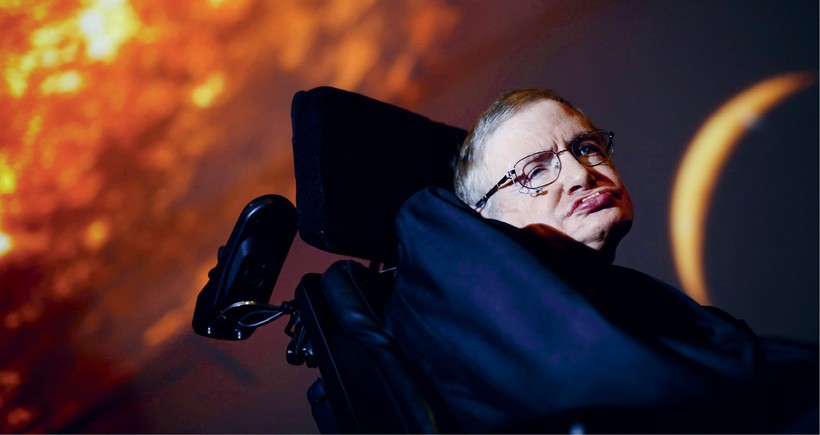
You jokingly referred to the Andromeda Nebula, saying that it would collide with us in two billion years and we need to figure out what to do. Do we need to think about the future using such horizons as millions and billions of years? Can we prepare for something that is clearly not our responsibility, something that is probably going to be addressed by our descendants a long time from now?
We can think about anything at all, no matter how near or how far, and the process can be quite productive. Everything is connected. Perhaps a nucleus will burst up in our galaxy. Perhaps it already has, and we just don’t know about it yet, but it will reach us tomorrow and we will no longer be there. Perhaps it makes sense to think about this because we can anticipate some things and prepare ourselves.
So we can seriously start thinking about what life will be like after we collide with the Andromeda Nebula? Or is it still too early?
Why not? It’s not all that time-consuming. And don’t forget there are objectives here that are closely linked to more practical things, if we need any justification. Behind this kind of work, there is a new kind of physics, and that might well produce something tangible, something we can use. If we think about black holes, we could discover new energy sources. We are talking about quantum physics, quantum gravitation – everything is linked.
People often find research interesting regardless of what direct benefits might be lurking there. If I’m interested in something, I don’t think about what I can gain from it; I just find it interesting, full stop. People live for their interests and those interests may be very different. In this sense, physicists and astronomers are making progress. We have made great strides in studying the Universe. With every new step the list of questions keeps on getting bigger, but so does the number of opportunities to implement something new.


